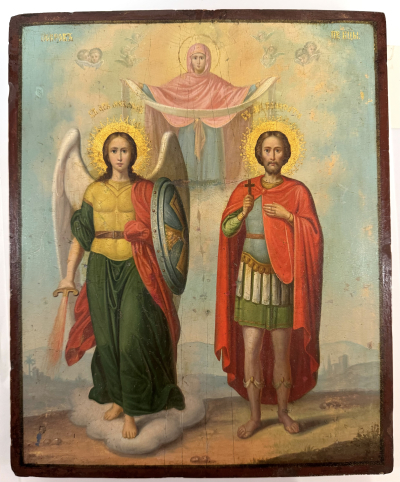The finely painted icon depicts the Guardian Angel and St. Boniface of Tarsus under the image of Our Lady of Pokrov.
The Protection (Pokrov) of the Most Holy Mother of God is one of the most beloved Feast days on the Orthodox calendar commemorated on October 1 celebrating the appearance of the Virgin Mary in Constantinople in the 10th century at the time when the people in the city were threatened by the Barbarian invasion. Saint Andrew, the Holy Fool with his disciple Saint Epiphanius, and a group of people, saw the Mother of God, Saint John the Baptist, and several other Saints and Angels during a vigil in the Church of Blachernae, nearby the city gates. The Mother of God approached the center of the church, knelt down and remained in prayer for a long time with her face drowned in tears. Then she took her veil off and spread it over the people as a sign of protection. After the appearance of the Mother of God, the danger was averted and the city was spared from bloodshed and suffering. On the icon, the Theotokos is depicted standing on a cloud in an aureola of green light with a city walls behind her holding her veil surrounded by apostles, saints, and two angels behind her. Below are Saint Romanos the Melodist, Saint Epiphanius and Saint Andrew the Fool.
In Orthodoxy, a Guardian Angel is a type of angel that is assigned at birth to protect and guide a particular person. Each human has a guardian angel who stands before the face of the Lord. This guardian angel is not only a friend and a protector, who preserves from evil and who sends good thought; the image of God is reflected in the creature—angels and men—in such a way that angels are celestial prototypes of men. Guardian angels are especially our spiritual kin. Scripture testified that the guardianship and direction of the elements, of places, of peoples, of societies, are confined to the guardian angels of the cosmos, whose very substance adds something of harmony to the elements they watch over.
Saint Boniface, the Martyr of Tarsus was a Christian martyr who was executed in the year 307 at Tarsus, where he had gone from Rome in order to bring back holy relics of the martyrs requested by his mistress Aglaida. Finding upon arrival at Tarsus that the authorities were torturing Christians, he openly declared himself to be a Christian. His own body constituted the relics that were brought back to Aglaida, who in turn also became a Christian. The Orthodox Church celebrates both of them on 19 December as the "Martyr Boniface at Tarsus in Cilicia and Righteous Aglaida of Rome".







 Change language to English
Change language to English